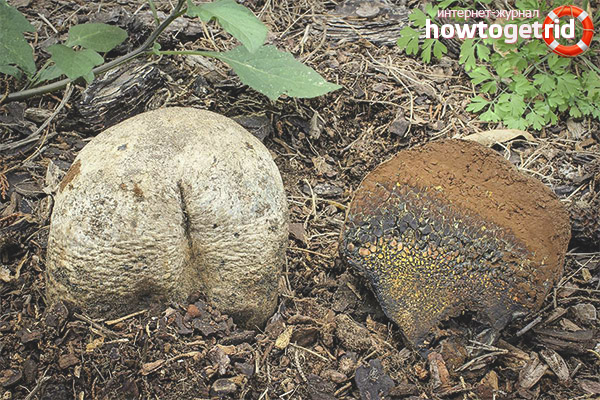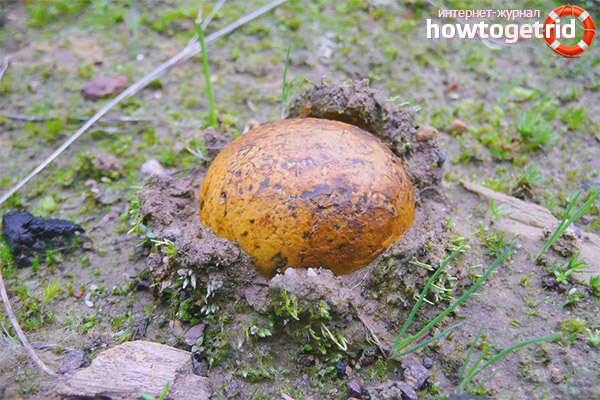The content of the article
Pyzolithus dyeing - refers to the types of mushrooms Gasteromycetes (family Pseudo-raincoat). Another common name for this type of inedible mushroom is rootless pisolithus. In Latin terminology, this species is designated under the name Pisolithus tinctorius.
Description
The fruiting body of this type of mushroom as pisolithus is quite large, in diameter reaches 110-120 mm, in height - up to 200 mm. The hat of the young representatives of the species is spherical; as it grows up, it transforms into a club shape. I would like to draw attention to the fact that the presented species of mushrooms has a pseudopod, the length of which reaches 80 mm, in diameter - no more than 20-30 mm. The structure of the legs is rather dense, elastic, and the surface is fibrous. In very young specimens of pisolithus, this part is extremely weakly expressed.
Places of growth
The fruiting season of this species is from the beginning of summer to late autumn. The rootless pisolithus grows both in small groups and in single specimens. For its growth, it prefers more acidic, depleted soils, and on the soil, characterized by the presence of a large number of limestone rocks, this type of mushroom does not settle. Pyzolithus is often found on logging sites already overgrown with vegetation, on dumps, quarries, and rarely - in deaf deciduous thicket.
Edibility of the species
Although most fans of quiet hunting consider this kind of mushroom as pizolitus dyeing inedible, nevertheless, according to some reports, it can be used in cooking without any fear for health. The main condition in this case is the collection of a mushroom crop, consisting solely of young specimens.
Ripe pisolitus in the territory of Southern Europe, as a rule, is used as a natural technical dye, from which, after a certain treatment, yellow paint is made.
Features

Due to the fact that the main place of growth of pisolithus tinctoria is depleted soils, the latter has a rather strong effect on the soil, which implies the restoration of its fertility, respectively, this type of mushroom is of great importance especially in the field of ecology. Often, pisolithus is planted specifically to restore sections of soil affected by industrial disturbances / disasters.
Similar views
Due to the characteristic appearance of rootless pisolithus, it is easy to distinguish from other species. This clearly indicates that this species has practically no similar representatives in the vast and diverse kingdom of mushrooms.
Benefit
Pizolitus dyeing is a mushroom that is also used for medical purposes. The composition of this species includes a certain biologically active substance called pisosterol, which is secreted from the fetal body for the subsequent manufacture of drugs, the main task of which is the fight against cancerous tumors.
Interesting Facts
Some types of gastromycetes are used in medicine: pisolithus - for the manufacture of medicines for oncological diseases and common fun - from such ailments as rheumatism and gout. Gleb of certain types of golovachey is an excellent hemostatic.
Today, the listed properties of the Gasteromycetes family are practically limited on this. In the long term, the study of species related to pisolithus as a source of biologically active substances and antibiotics, which are currently isolated only in some species of golovache, as well as in such a fungus as giant langerium. That is, this suggests that such a species as pisolithus and its varieties is a peculiar and little-studied group of mushrooms.










Submit